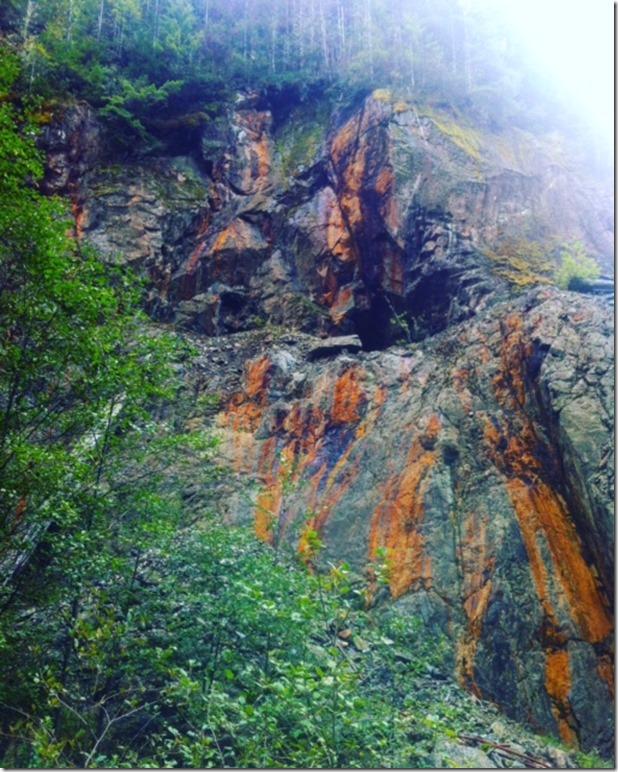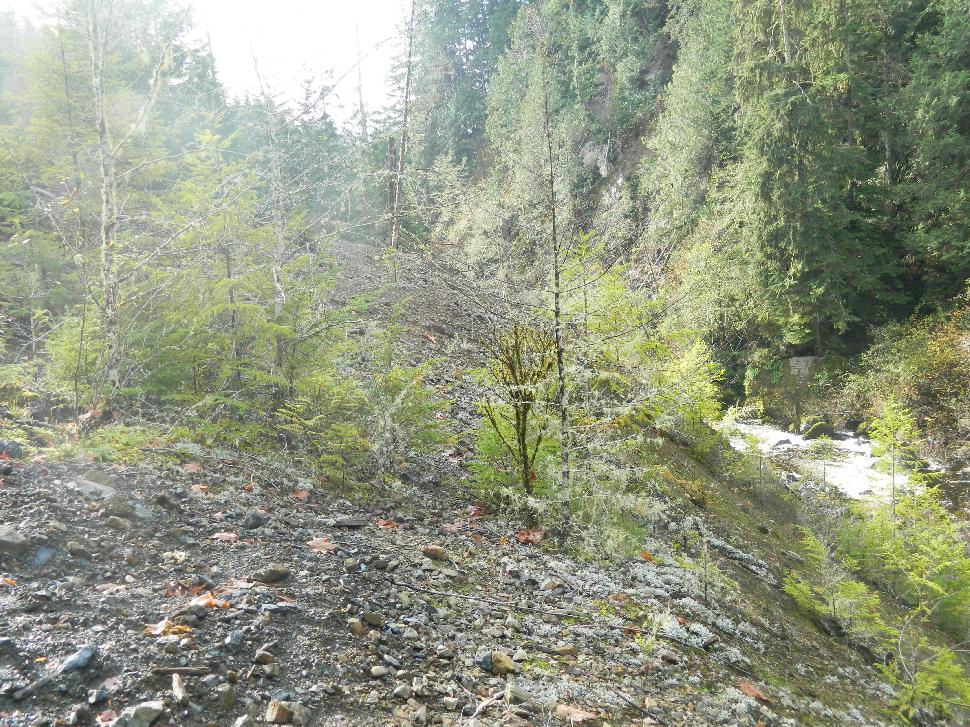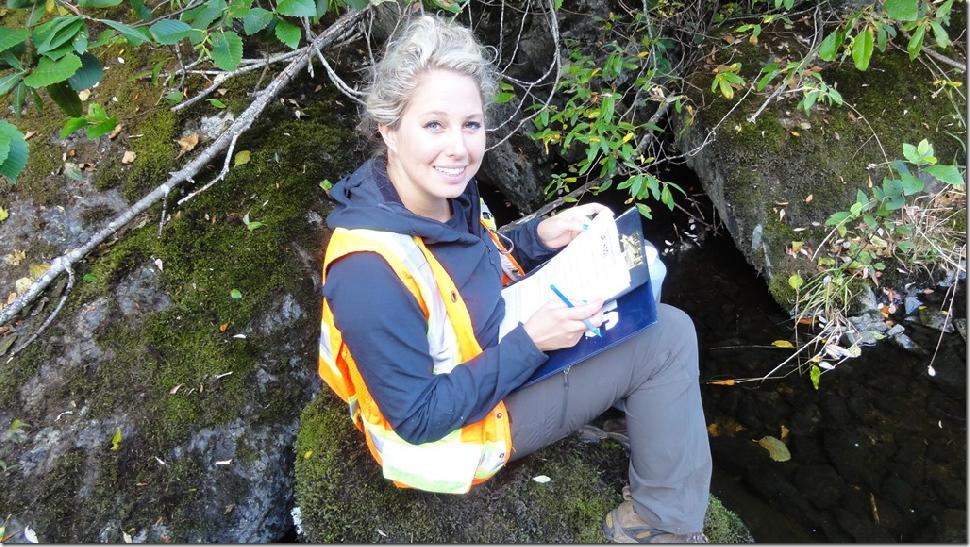The Jordan River is a small river by Vancouver Island standards. It is located half way between Sooke and Port Renfrew and can be found by taking the Colwood exit off Highway 1 to Highway 14 and following the scenic route past the village of Sooke. The river flows along a north to south course draining the lands from San Juan Ridge to sea level. Before emptying into Juan de Fuca Strait it passes by the Western Forest Products log sort, now operated by Queesto Logging, adjacent to the town site of Jordan River. There is a small CRD campsite on the beach west of the bridge where surfers can be seen riding the waves.
Advertisement
Its watershed structure is different from most on Vancouver Island. They follow relatively straight courses on their way through steep- sided valleys. However the bulk of the Jordan’s watershed runs east to west while the river flows at 90 degrees down a steep canyon before reaching its estuary. Essentially the river and the watershed resemble a large “T”. The Jordan is also different because of other factors and those factors produced damaging outcomes.
History
First Nations
Native history reveals the Jordan River estuary was initially settled by tribes crossing from the Olympic Peninsula. At its peak the village of Diitiida may have included as many as twelve long houses. The modern name is Dididaht. In its natural state the river may have supported combined annual runs of five to 10 thousand chum, pink and coho salmon, excluding native trout. The ocean has always been a rich food source while the estuary contained elk, deer, game birds and timber. In spite of apparent resource abundance, at some point the villagers moved to Port San Juan where they became known as the Pacheedaht people. The name translates to “children of the sea foam” and carries an interesting story about the name change. One day strange foam was discovered on the waters of the San Juan River. They wanted to find out if it was safe so they had an old and apparently expendable slave women taste the foam. It didn’t harm her so the tribal name changed to “children of the sea foam” or Pacheedaht. A permanent village was never re-established at Jordan River but it is still part of Pacheedaht traditional territory.
Advertisement
Early European Contact
The Spanish exploration of these waters preceded Cook’s 1778 visit to Vancouver Island. A cursory look at BC coastal maps will confirm that the Spanish either named or had their names attached to many important geographic features. Mount Manuel Quimper, Port San Juan, San Juan River, Bonilla, Sombrio and Magdelena Points are examples of sites near Jordan River with Spanish connections. However the Spaniards did not leave a permanent imprint on the land or the native culture. That task fell to the English and those who followed them. Their influence swamped native societies and fundamentally changed the history of southern Vancouver Island forever. By modern day standards it’s easy to judge these adventurers and early immigrants harshly. Particularly in the way they treated native communities and their apparent reckless use of natural resources. However doing so is a historical reality. During the age of discovery European powers were primarily motivated by conquest and the acquisition of land and wealth, so dominance over native populations was an accepted consequence of exploration. That mindset extended to controlling the land and shaping it as they wished, regardless of the damage done. From first settlement to the mid 1990’s resource extraction was justified on the misguided notions that natural wealth could never be exhausted, or that less valuable resources could be sacrificed to make way for more impressive enterprises. Major resource extraction on southern Vancouver Island began about 150 years ago and grew rapidly well into the 20th century. Jordan River did not escape this trend.
Industrial Impacts Affecting the Jordan River
Logging and fishing were Vancouver Island’s principle historic economic activities. Logging dominated but intensive commercial fishing in Juan de Fuca Strait would have impacted adult fish headed to the river to spawn. There is anecdotal evidence that local residents fished the river but not extensively. While these activities affected Jordan River salmon they were not responsible for driving the stocks to extinction.
Advertisement
The fact that hydro dams were constructed on the Jordan over a hundred years ago is news to many southern Vancouver Island residents. The Vancouver Island Power Company began construction of three dams, two reservoirs and a powerhouse in 1911. At completion the Diversion Dam was the tallest in Canada. Over time improvements were made with the most significant coming in 1971 when a new tunnel and powerhouse were build increasing production from 26 megawatts to 175 megawatts. According to Ken Farquharson, an engineer who periodically did contract work for BC Hydro, the facility is a peaking plant that runs intermittently resulting in variable river flows. This can cause difficulty for fish in the river. This sentiment was echoed by Jamie Constable, a University of Victoria student doing her Master’s thesis on the Jordan River, who noted that pre-1971 hydro activity would not have had major impacts on fish stocks because the original tailrace offered good spawning habitat, lots of gravel and consistent flows. In 2013 Jordan River made headlines when BC Hydro raised the alarm about dam stability should a very large earthquake affect the area. As a result Hydro bought out the residents whose properties might be threatened by a structural dam failure. However, like logging and fishing hydro generation may have contributed to stock declines but not stock extinction.
Southern Vancouver Island also experienced significant mining activity. In the 1860’s there was a short lived gold rush on the Leech River which led to the construction of Leechtown. There were also rumors of a legendary mother lode of gold discovered by the Spanish along the San Juan River. While stories of undiscovered gold and gold rush fever intrigue us it was a comparatively mundane but versatile metal that sealed the fate of Jordan River salmon. That metal was copper.
Jordan River copper mining began in the early 1900’s and continued on a modest scale until 1960. Large scale mining took place between 1961 and 1974 with sporadic breaks in activity due to fluctuating copper prices. Teck-Cominco was involved in the mine from 1917 until 2003, although it periodically operated under other names including Cowichan Copper, Jordan River Mines and the Sunro Copper Mine as it is known today. The mine has not operated for many years.
The Problem
There have been numerous media reports about copper contamination problems on the Jordan River. Heavy metals have been leaching into the river for decades even though the site was closed after the mine shut down. The closure was approved after a cleanup that was in accordance with the mining regulations of the day. It is also important to realize that the mine was built following one hundred-year-old codes and regulations. In those days the effects of mining operations were not as well understood. In both the construction and closure phases the authorities acted according to existing guidelines.

This was a substantial underground mining operation. There were extensive access tunnels, shafts and large caverns called stopes that were left after the ore was extracted. The tunnels also led to underground rooms that housed rock crushing machinery and other mining equipment. At one point a rich vein of copper was discovered directly under the river. The process of removing the ore created a stope which collapsed in 1963. This diverted the river flow into the mine and access tunnels with enough force to eject rock and mining debris from the mine. Cominco did plug the breach but there was so much material in the river that it had to be removed and dumped on what is now the log sort site. In 1977 the main tunnel collapsed and mining ceased. However these dramatic events were not the only concerns with the mine. Large debris piles, consisting of waste mine rock and spilled tailings, are still located on the river’s steep banks. A tailings pipe was also constructed which emptied directly into the ocean. As noted in a Vancouver Sun newspaper article this pipe is an example of “how not to build a tailings pipe”. The concrete buttress for its outflow can still be seen close to the beach just east of the highway bridge.
In 1991 Kaleen Kilby conducted a study on the extent of marine mineral placers in Juan de Fuca Strait. She noted that “the areas around Jordan River, in particular Sandcut Beach, appear to hold the greatest zone of enriched heavy minerals and trace metal values”. This placer extends roughly a half kilometer from shore and “tailings from the Sunro Mine located 2 km above the mouth of Jordan River were the source of the heavy minerals”. While this indicates significant mineral migration and deposition along the shore line the main problem with the Jordan River continues to be the leachate seeping into the river. Constable describes the leachate damage this way: “The leachate is created by a chemical reaction caused by the exposure of mine tailings to oxygen and surface water increasing the acidic solution and forming a heavy metal run-off”.

Fortunately there is good news for the Jordan River. Concerned individuals, the regional government, Pacheedaht First Nations, Teck Resources, BC Hydro, Fisheries and Oceans, Ministries of Environment and Mines, salmon enhancement groups and academics from the University of Victoria and elsewhere are pulling together to remediate the river and restore salmon runs. The situation is complex and the parties are still trying to form a roundtable to coordinate planning. Jamie Constable noted that her role is just one small part in a big plan and “by the summer of 2017 they will know where this is going to go”. In late 2016 she and I visited the area including parts of the abandoned mine site. I was able to learn about her work, how that fitted into the overall restoration plan, who else was involved in the process and what had been done to move this project forward.
Constable was born in Sooke and is an active outdoor enthusiast who enjoys fishing, hiking, hunting and volunteering at Sooke’s Jack Brooks Hatchery. She is also an Articling Agrologist with a Bachelors degree in Physical Geography and has worked as a field technician doing mineral exploration surveys at remote Canadian locations. She is currently completing a Master’s degree in Geography at the University of Victoria which led her to the Jordan River. Her thesis is based on creating a baseline
water quality study that will be available to anyone who is involved in future work on this system. This work builds on local governance initiatives happening in the watershed. This close connection with the river inspired her to become a long term advocate for its stewardship and recovery. She described her work as “combining education with community benefits”. Her 2015 water quality study was based on sampling five sites for copper, dissolved copper, dissolved organic carbon, sulphate, suspended solids, acidity, hardness and turbidity using Ministry of Environment Water Quality Sampling Guidelines. Data taken from sites downstream of the mine and the tailings piles showed levels that exceeded BC Provincial limits for copper in marine environments.
Ken Farquharson is a retired resident of Metchosin and another advocate for the Jordan River. While working as an engineer he periodically did contract work for BC Hydro. From that association he was asked to sit on Hydro’s Coastal Fish & Wildlife Compensation Program. In 2013 the Jordan River came under review primarily to determine flow levels required to provide enough dilution so that fish could be re-introduced to the system. This led Ken on a complicated journey. It began by contacting Calvin Sanborn of the University of Victoria’s Environmental Law Center to ask for help in determining the responsible parties under the Contaminated Sites legislation. Sanborn asked Law Center student, Matthew Nefstead, to take on Ken’s request. Neftstead found that Cominco were the owners of the site during mining operations and that Western Forest Products were the current land owner. Farquharson and Sanborn drafted the initial letter that was sent to Teck Resources and Teck subsequently acknowledged their share of the responsibility. Teck then asked Farquharson to set up meeting with the interested parties including the Ministries of Environment and Mines. Afterwards the Environment Ministry requested that Teck undertake a Risk Classification study for the site. The study was completed in 2016 and it revealed that the site was ranked as High Risk. As a result the Ministry ordered Teck to prepare a site remediation plan by June 1st 2017. BC Hydro has also been a pro-active partner on the Jordan River. The company has been funding studies proposed by the Pacheedaht First Nations through their Fish and Wildlife Compensation Program, as well as trying to determine adequate base flows that will sustain fish and fish habitat. Both Ken and Jamie have been impressed by the cooperation received by Teck Resources and BC Hydro; as well as the research done by the University of Victoria’s Environmental Law Centre and the Geography Department’s support for Jamie’s thesis concept.

Jamie and Ken provide us with a snapshot of ordinary people who are committed to bringing fish back to the Jordan River. In fact Ken gets the credit for coining the phrase “Salmon in the Jordan River by 2020”. Right now the prospects look promising and should improve once the Jordan River Roundtable is in place. However no one is underestimating the magnitude of the task. Fortunately there are examples of successful remediations where copper was involved. These include Britannia Creek in Howe Sound and the Tsolum River near Courtenay. Their stories may offer additional answers to Jordan River’s problems thus improving the chances for positive outcomes.